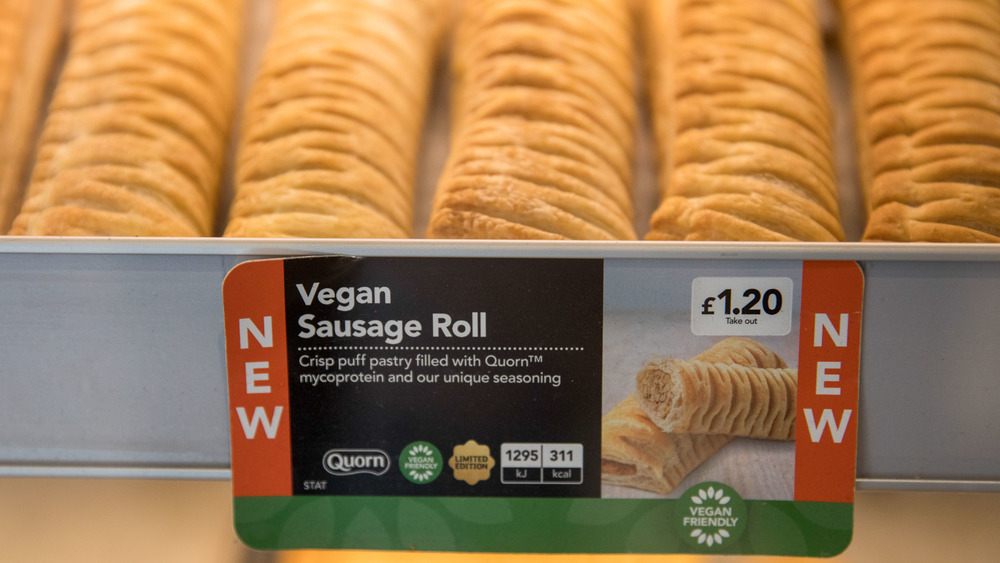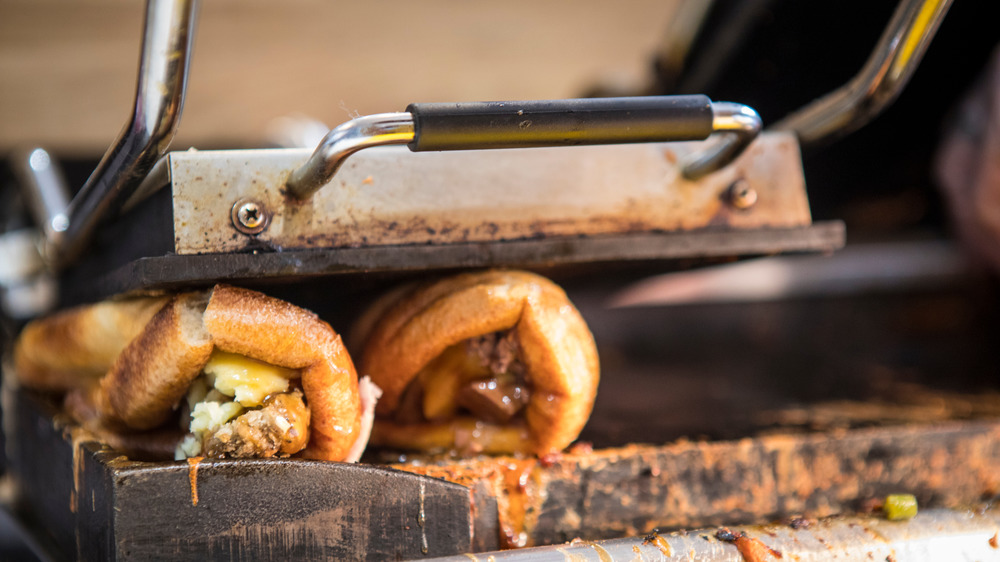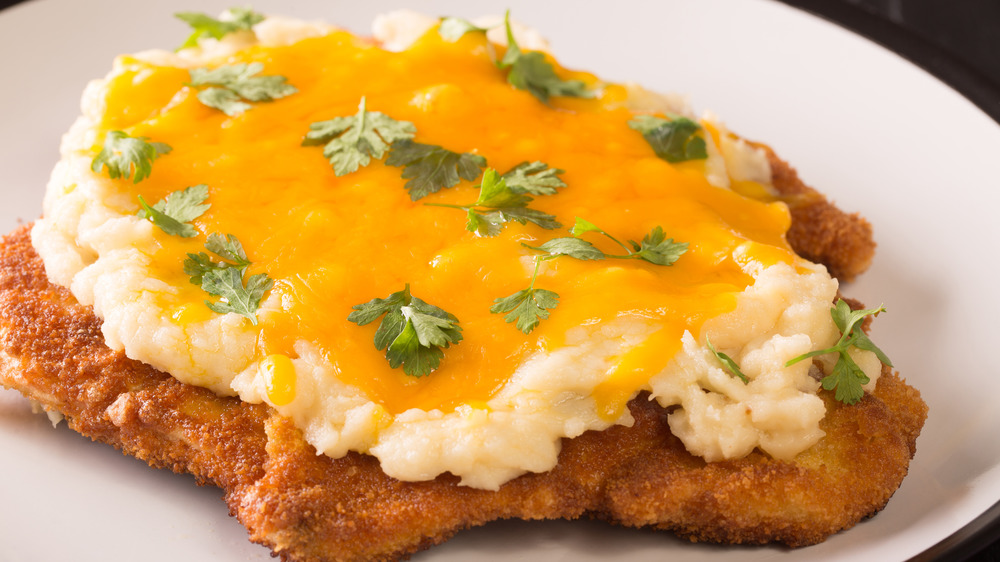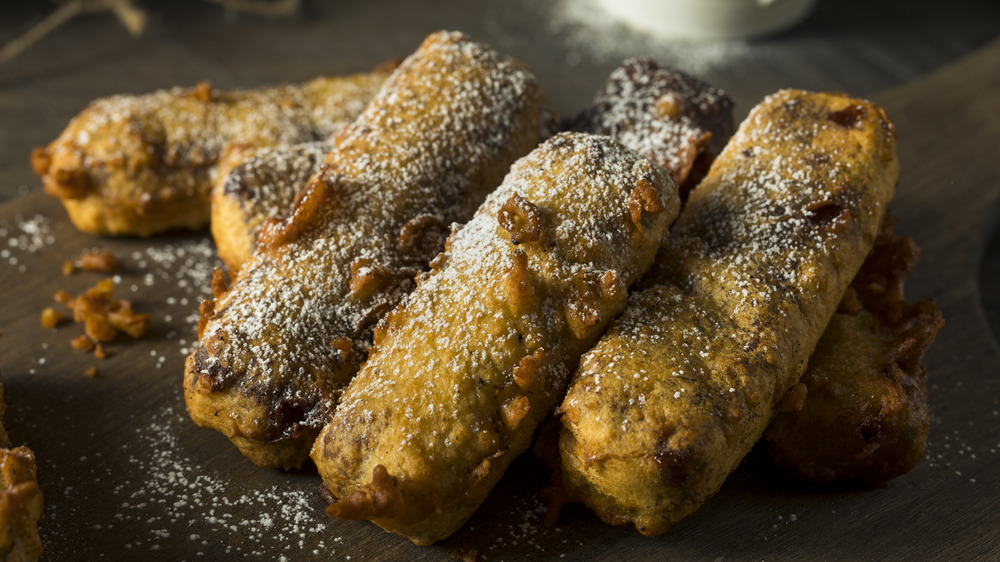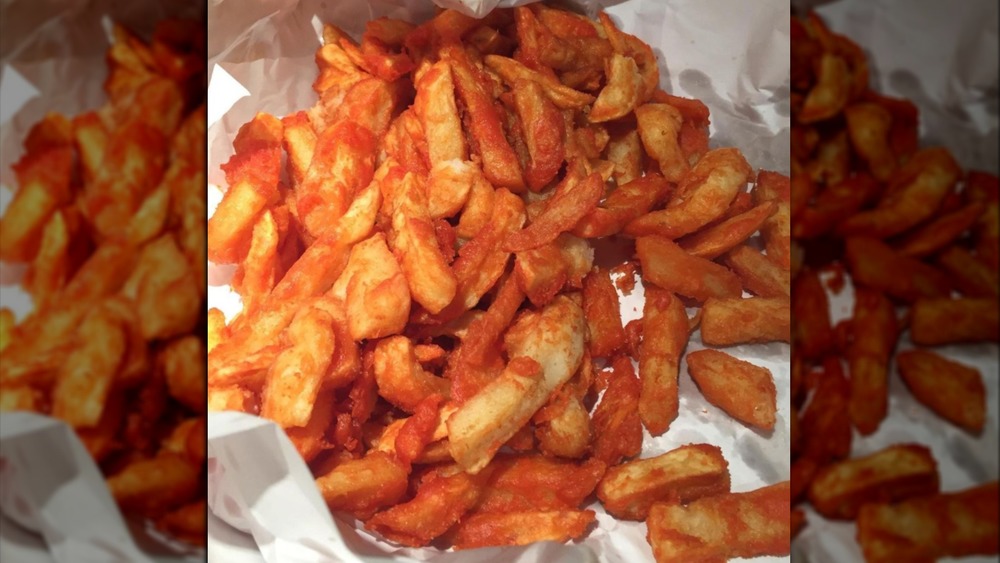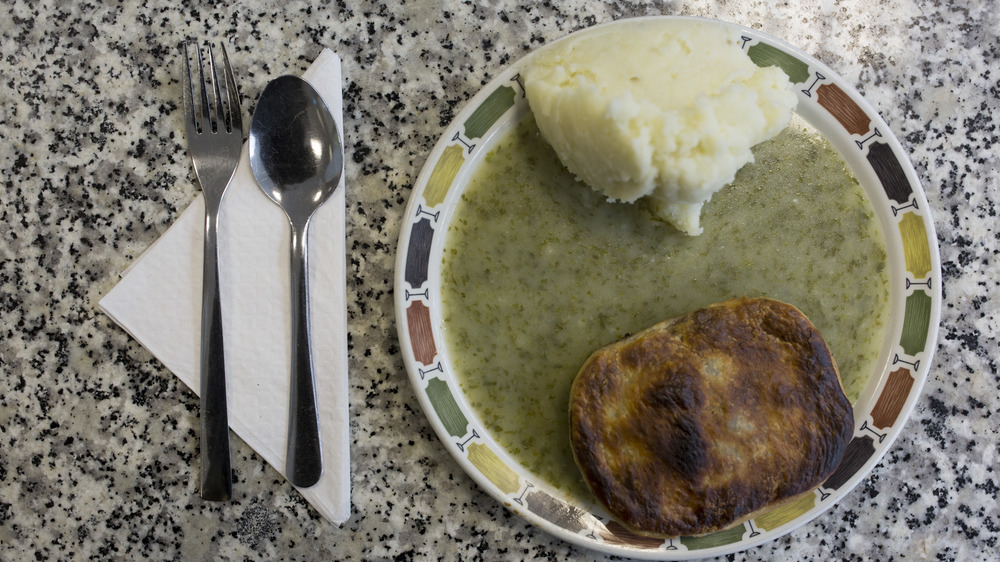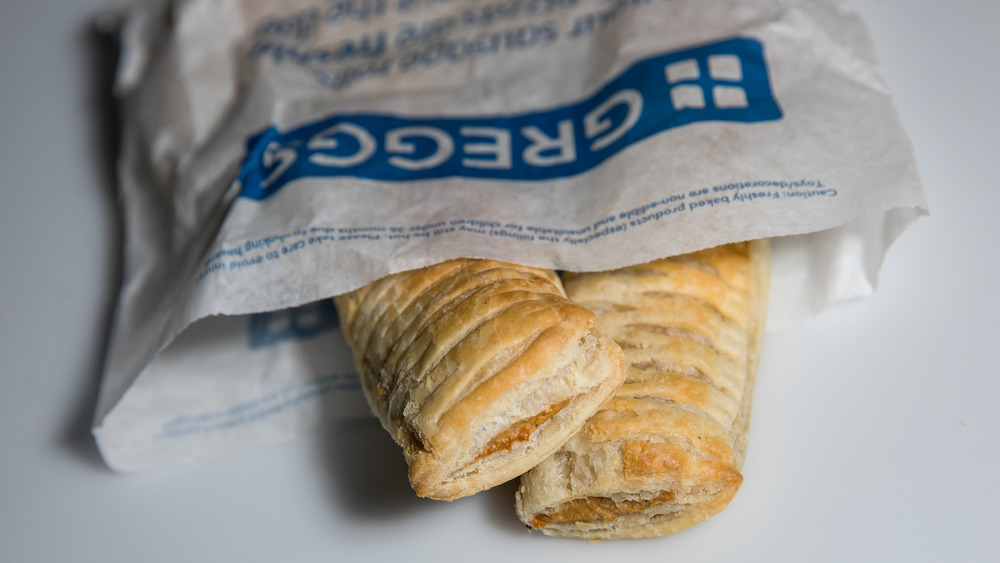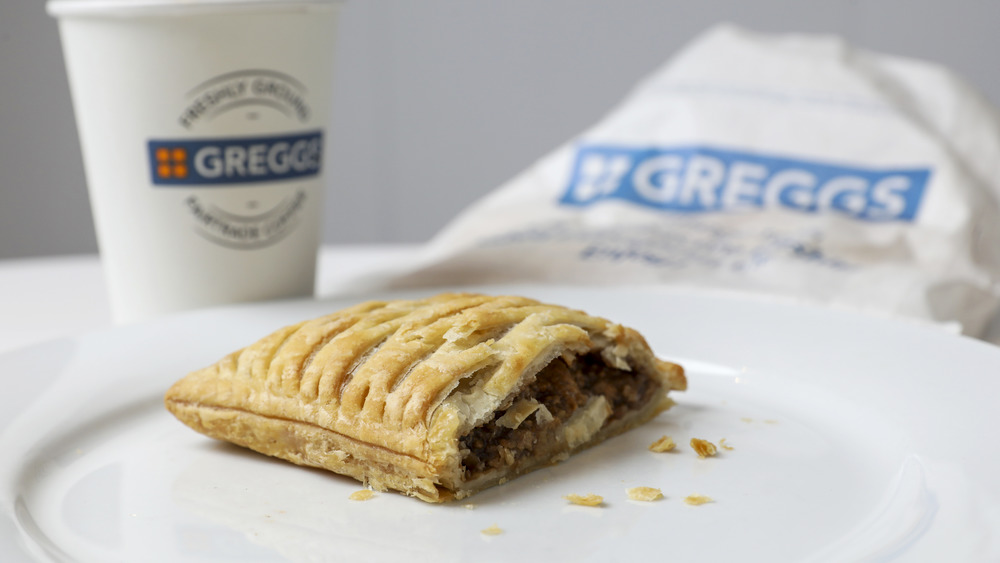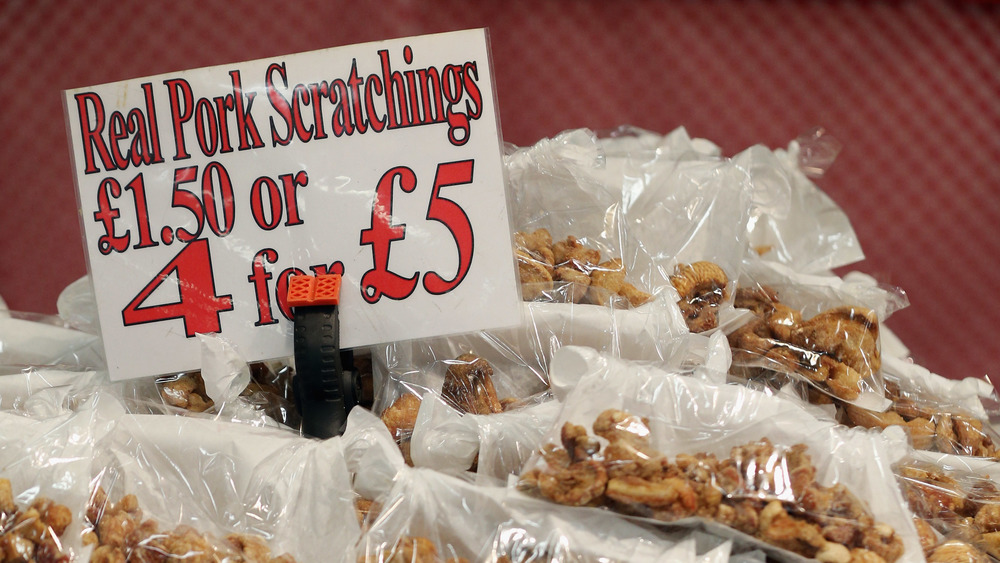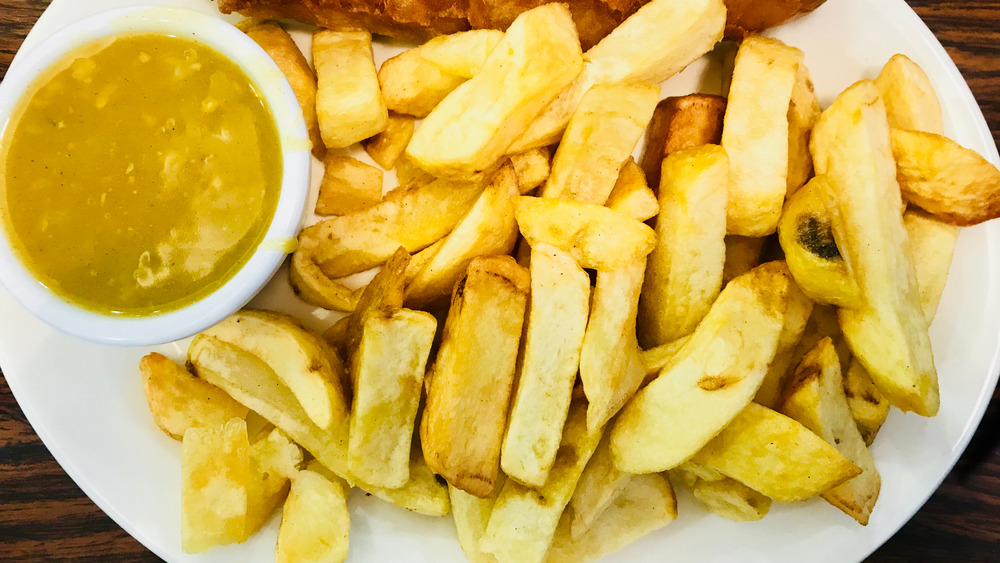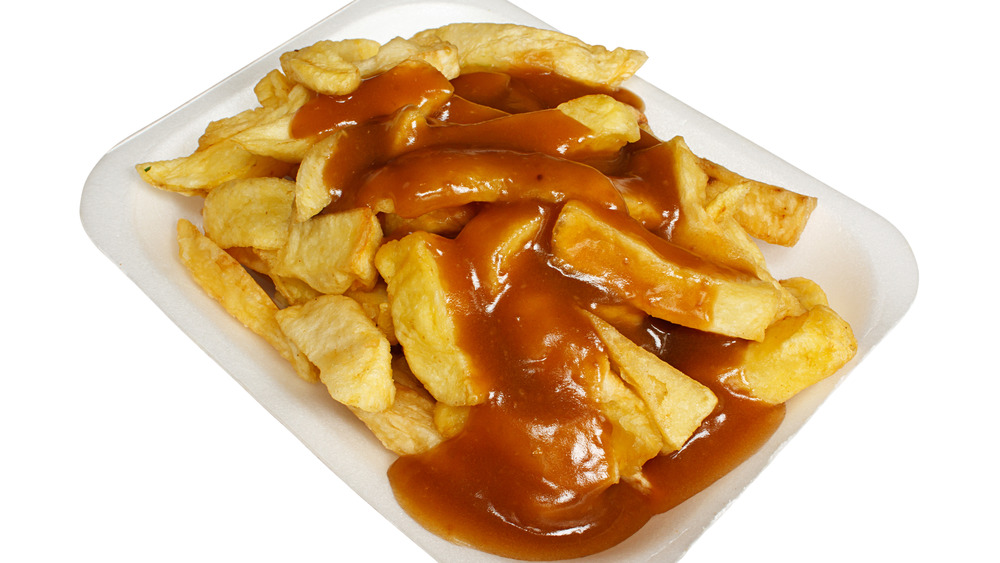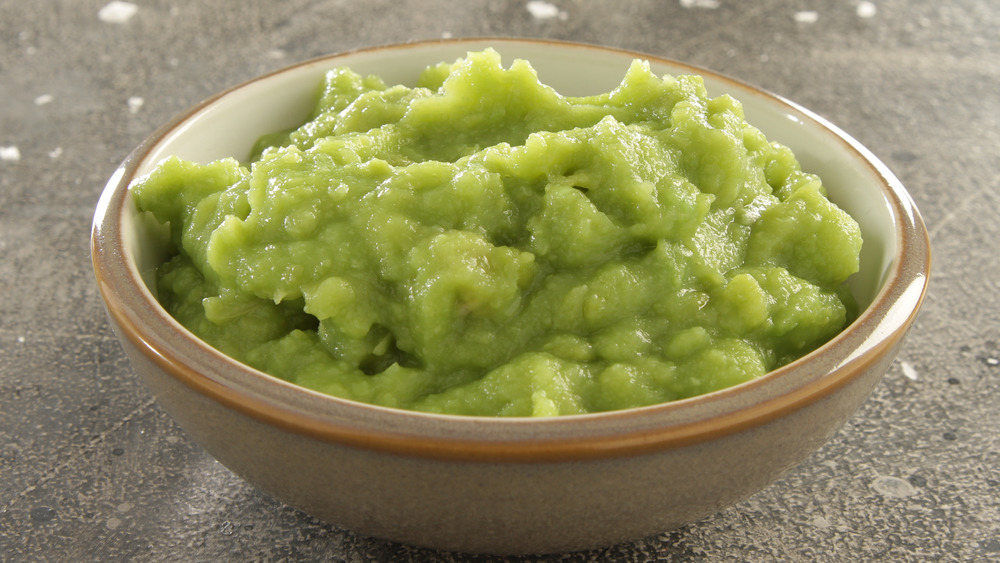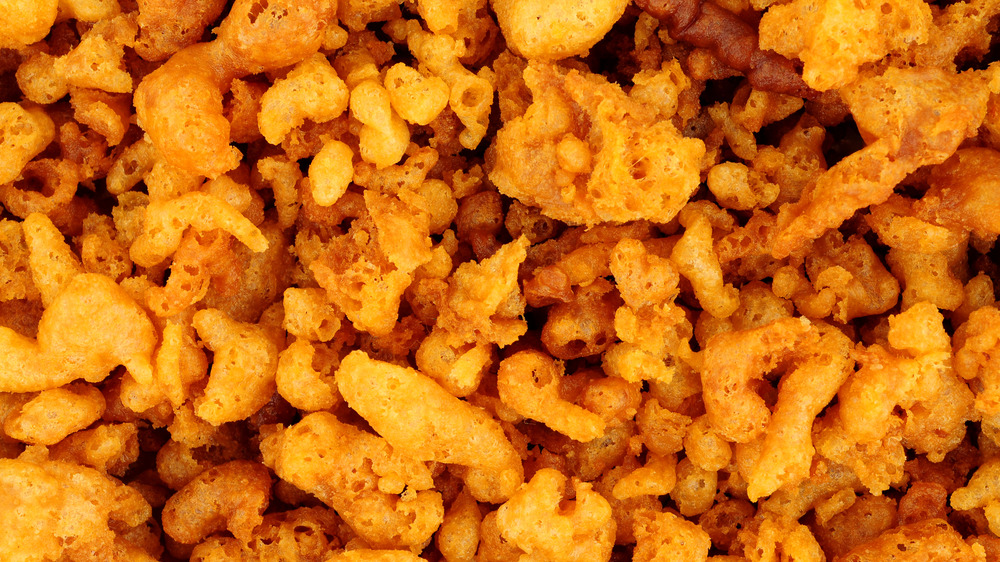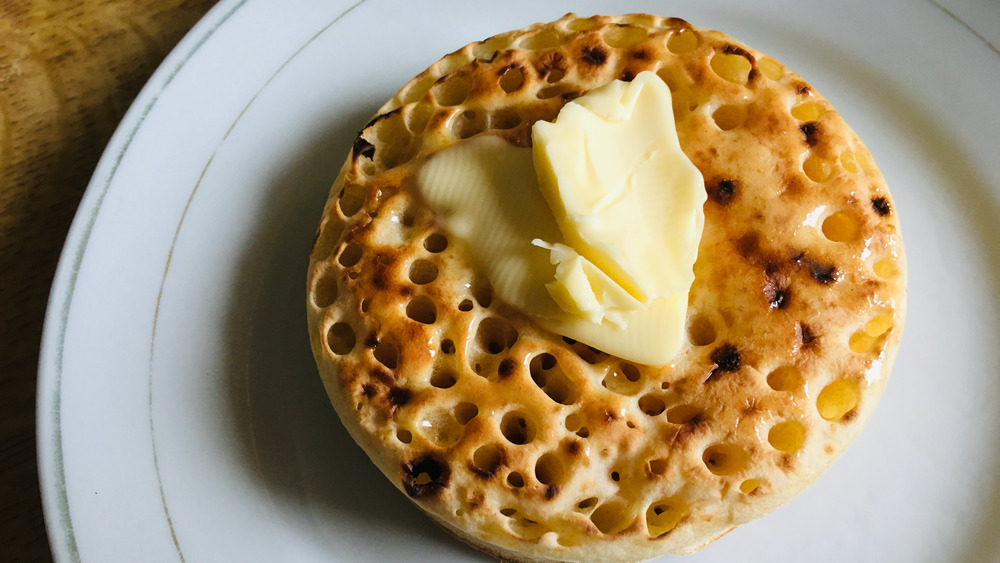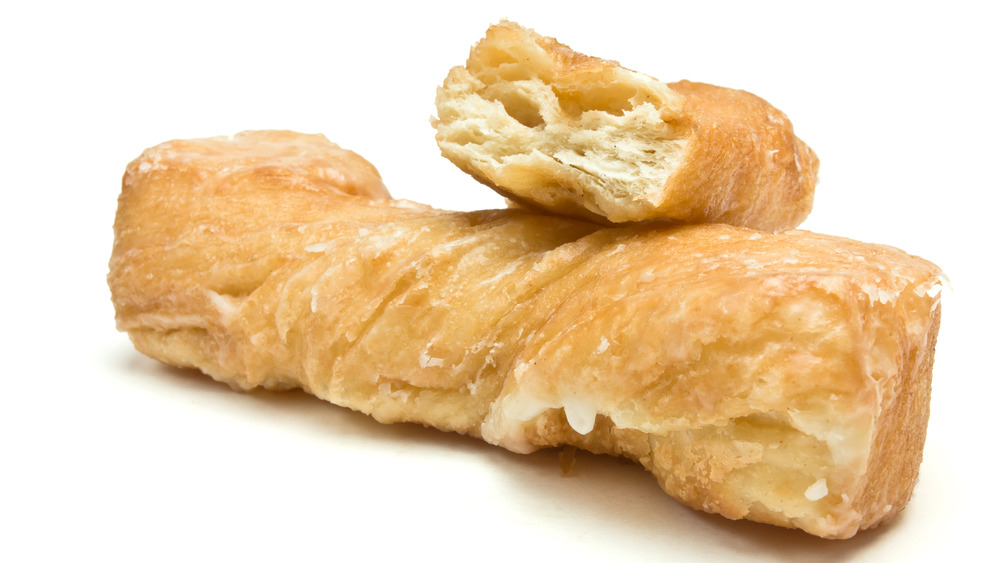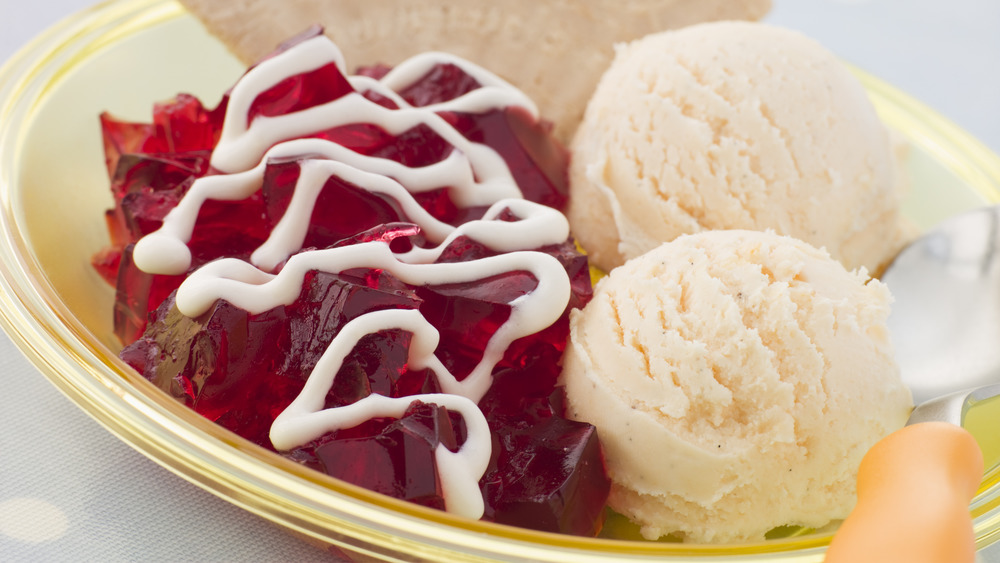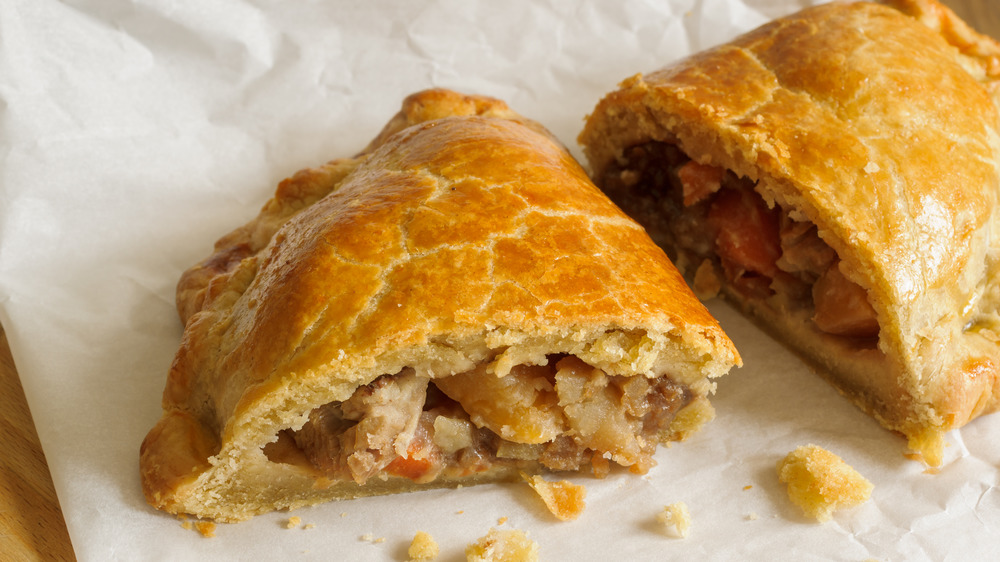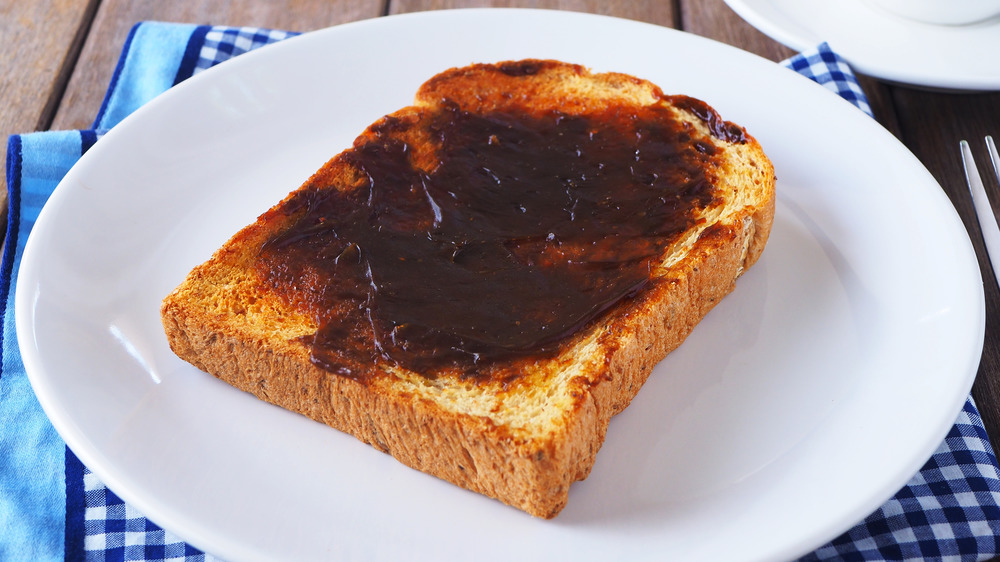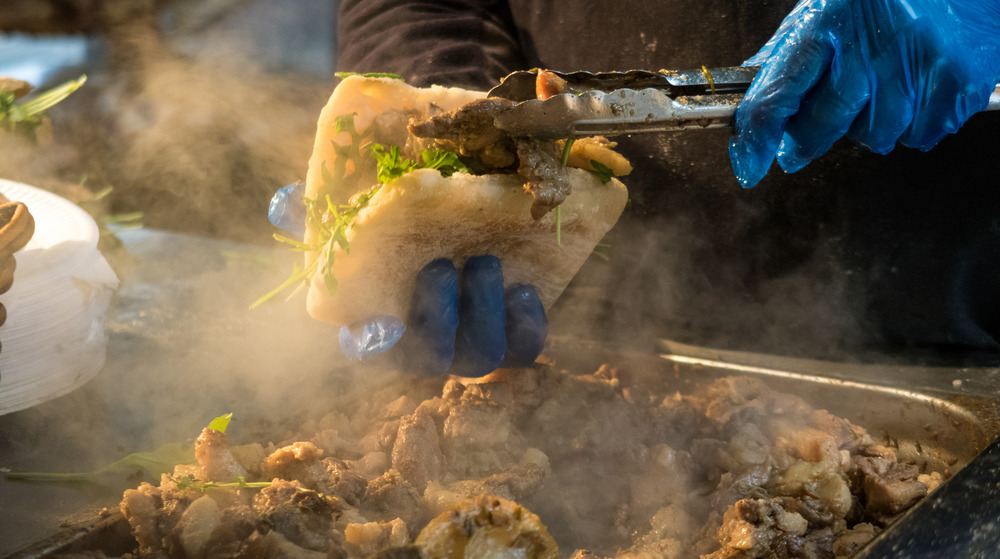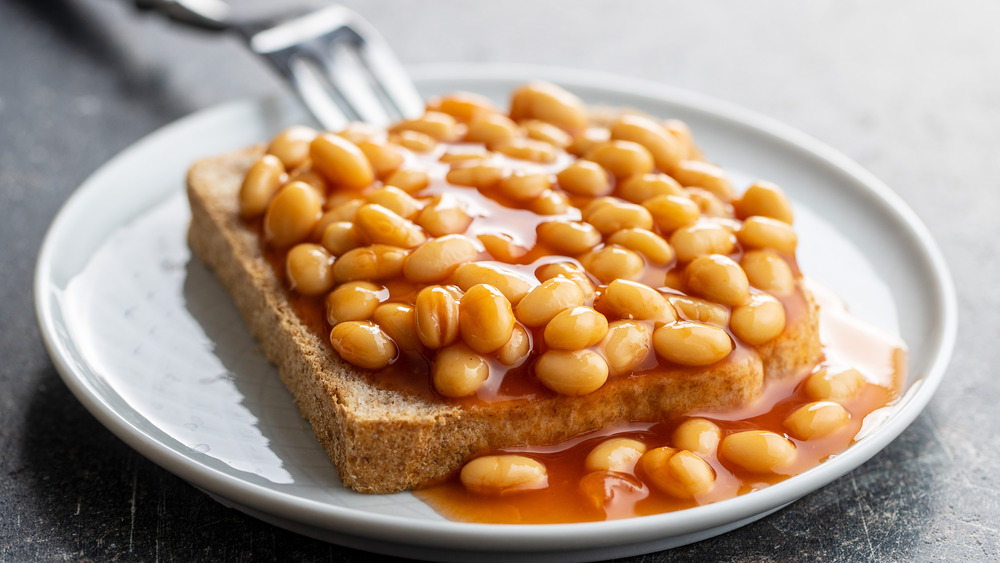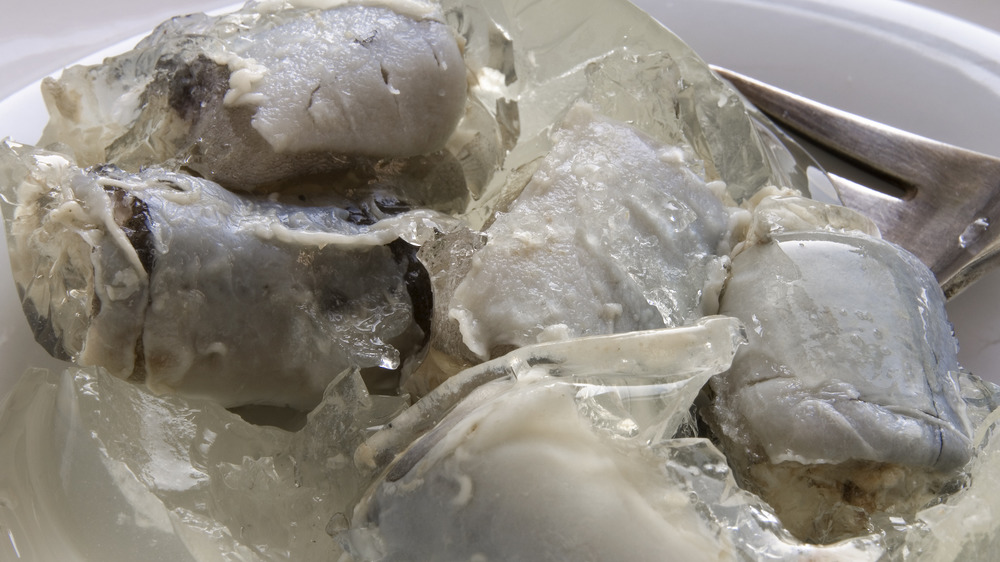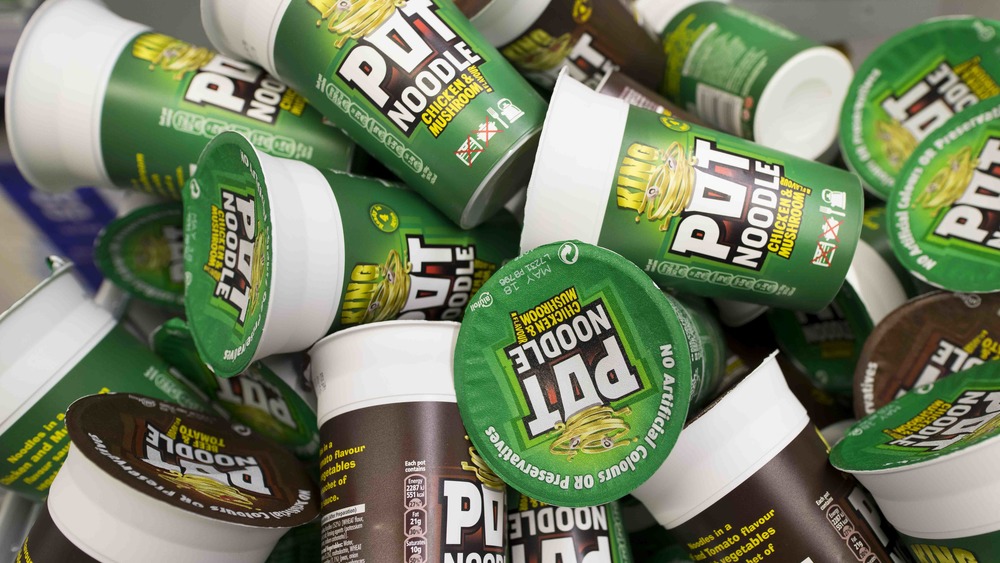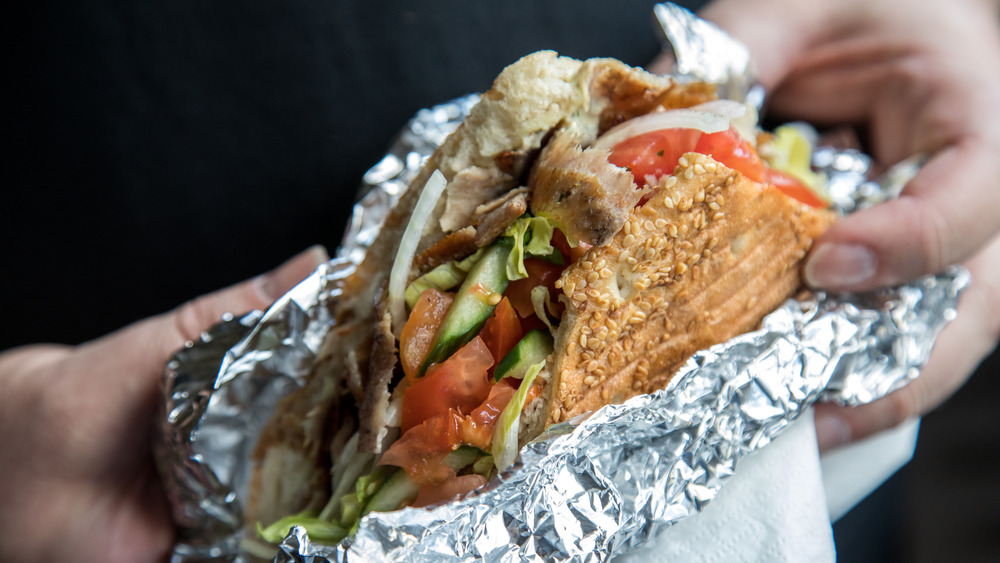British Junk Food You Should Try Before You Die
We may receive a commission on purchases made from links.
Think America has the crown when it comes to junk food? You might want to think again. Travel across the seas to Britain, and you'll find a colorful selection of calorific treats in eateries, cafes, diners, and more. Whether you're craving something deep-fried and sweet, or lust after an entirely savory snack, there's certain to be something that will have you salivating in mere seconds.
Ready to take a quick foodie tour of Great Britain? Grab your passport (okay, not really!) and follow us. The truth of the matter is that this island is bursting at the seams with junk food options. Let's take a look at some of the most irresistible dishes including regional favorites and all-time must-eats.
Yorkshire pudding wraps are a British popover upgrade
A regular on traditional Sunday dinners, Yorkshire puddings are the U.K.'s equivalent to popovers. Fluffy, crispy, and perfect when doused in gravy, these filling extras are made from a simple batter of eggs, milk, and flour.
You get no prizes for guessing that these treats hail from "God's Own Country, Yorkshire. Originally served as an appetizer, the puds were used to fill people up ahead of chowing down on the main meal. Since meat is an expensive commodity, that meant that the cooks could make it stretch much further; filling up multiple hungry bellies.
Flash-forward to the modern day, and Brits still love Yorkshire puddings. So much so that vendors in York and Leeds have had the somewhat genius idea to use them as wraps. Packed with meat, gravy, and even traditional veggies, the wraps make ideal hangover snacks or heavy lunches. If that's not to your taste, the BBC also reported that vendors in Hull are now serving up delicious Yorkshire pudding pizza. Yes, please!
British Parmo is a step beyond Chicken Parm
Picture this: A breadcrumbed fried chicken fillet, smothered in béchamel sauce, topped with grated Cheddar cheese, and then grilled. If your mouth isn't watering at the thought of this, frankly, erotic combination, go back and read that last bit again.
The chicken parmo (or simply 'parmo' to those in the know) is a late-night Teesside delicacy. The story goes that Nicos Harris, owner of The American Grill restaurant in Middlesbrough invented the snack in 1958, reports the BBC.
Originally dubbed 'escalope parmesan', the dish was made from either chicken or pork meat. Over the years, it's become a staple for takeaways ("takeout" if you're American) in the Teeside area. When you're done drinking and dancing the night away, heading to a late-night eatery to grab one of these treats, in a pizza box no less, is a fitting end to the evening.
Locals are so enamored with this creation that they launched the World Parmo Championships in its honor. While there was a lull and the competitions stopped in 2015, Middlesbrough's elected mayor, Andy Preston, brought them back in 2019.
Deep-fried Mars bars put American state fairs to shame
First things first, there's something you should know: The UK version of a Mars bar is not what you may imagine. You'll find no almonds here. Instead, the snack features nougat, caramel, and a chocolate coating. The simplest way to describe it is like the American Milky Way bar. (Side note: The UK Milky Way is also different, but that's another story!).
Now that we've got the red tape out of the way, let's talk about how Scottish chip shops, including those that take the chocolate bar to a whole new level. Yes, they cover a Mars bar in batter and then pop it in oil — the result is an uber-sweet snack that's delightfully crispy on the outside and perfectly gooey on the inside. While MyFitnessPal estimates that these treats come in at around 600 calories, they're truly worth it for the experience alone. So, you might be wondering, how did the Scots come up with this daring feat of culinary excellence?
Rumor has it that the origins of the deep-fried Mars bar date back to 1995 at The Haven Chip Bar (now The Carron) in Stonehaven, Scotland. When a dare led to a young man asking the chip shop owners to deep-fry the chocolate treat. Luckily, they obliged and something of a national phenomenon was born. The rest of the UK has since followed suit in enjoying these indulgent treats.
British orange chips are not your average battered fries
If you know anything about UK cuisine, you will know that fish and chips are the cheap takeaway of choice. But, should you venture to the Midlands or, more specifically, the Black Country (also known as the West Midlands), you will find an entirely new take on the humble chip.
As bright as they are satisfying, orange chips are exactly what they say on the tin. Crispy, warm, and luminously orange in tone, these fried snacks are a cut above your standard offering. The chips get their distinctive look by being covered in batter before being fried.
Want to know how to make them for yourself? Tough luck. Major's chip shop, one of a few places you can snag yourself these treats, makes the batter from a top secret recipe. While many have tried to claim this 'invention' over the years, it's unclear who first made the now-famous orange chips. One thing is for certain, though. If you're ever in the area and pop into a select chip shop, you absolutely have to try them for yourself.
Pie and mash is British comfort food for the masses
Hailing from London's East End, pie and mash is proper British working class food. The traditional form of this UK delicacy consists of a mince-beef pie and a scooping of mashed potato on the side. Top that with some parsley sauce known as liquor, and you've got yourself a meal Sweeney Todd would be proud of (minus the human meat).
This combo has been commonplace in British cuisine since the 19th Century. However, the modern-day take on the meal may be a little different. While you still get old-fashioned pie shops in the East End serving up the original offering, contemporary eateries offer a wide range of pie fillings and sneaky extras to make your meal special.
Head to a traditional British pub and you can likely find a variety of pies from leek and potato to chicken and mushroom served with a side of mash and maybe even some gravy.
Greggs sausage rolls (and vegan rolls) are a British puff pastry treat
Started by John Gregg 80 years ago in Newcastle to supply local families with fresh eggs and yeast, Greggs has snowballed into a real British institution. The company's first bakery opened its doors ten years after Gregg launched the delivery service. Fast-forward to the present day, and there are now over 1,950 stores around the country. It's a huge deal.
While the franchise sells a whole variety of baked treats, sandwiches, and coffees, one of the most popular food items has to be the Greggs sausage roll. With something of a cult following in the UK., the snack consists of seasoned sausage meat wrapped in puff pastry and baked.
For a long time, the roll was the king of treats at the eatery, but 2019 would change everything. That was the year that Greggs released the vegan sausage roll. Vegetarians and vegans across the country went wild. The plant-based snack includes the same scrumptious puff pastry outside with a bespoke Quorn filling. We'll take two!
Greggs Vegan Steak Bake are a must-try for meat lovers and vegetarians alike
Can you imagine queuing through the night to get yourself a pastry snack? That's exactly what many people did when Greggs released their vegan steak bake in 2020. An apt sequel to the 2019 hit, the vegan sausage roll, the pastry drew in quite the crowd. Literally.
As part of a Veganuary promotion last year, Greggs announced the release of the vegan alternative to a classic steak bake. Featuring 96 layers of light puff pastry and Quorn's savory flavor mycoprotein pieces plus onions and gravy in the middle, it was a revelation. The Greggs site says the snack was "designed to mirror some of the original Steak Bake's classic features." It is an absolute must-try.
Pork scratchings are the British answer to pork rinds
Pop into most pubs in the UK and you will find the standard bar snacks on offer. Most of the array will be somewhat familiar to you. You've got crisps (i.e. chips), nuts, and perhaps the odd cheese sandwich. So far, so basic. However, there's one sneaky little snack that you may not have come across: the pork scratching.
Deep-fried pork skin, hairs and all, pork scratchings originate from the Black Country in the Midlands. Dating back to the 1800s, the traditional snacks were made by families who would slaughter pigs and then—to save wasting the skin—fry it. By the 1930s, butchers started to sell the salted skin-based snack and the rest is history.
The classic snack comes salted. However, in recent years, there's been a rise in so-called luxury pork scratchings, the likes of which feature flavors such as habanero chili.
Chips and curry sauce are a British fusion fave
Should you find yourself in a British chip shop late at night, there are a few junk food options you simply have to try for yourself. The first is chips and curry sauce. As the name describes, this is a tray of freshly-fried chips (yum!) along with a topping of curry sauce.
How to best describe classic British chip shop curry sauce? It's a lot like katsu curry sauce. Orangey-brown in color, thick in consistency, and with a low hit of heat, it works perfectly with a hot pile of just about anything. The ingredients of this topping include curry powder, turmeric, onions, butter, ginger, chicken stock, corn flour, and vinegar.
If you're wondering where in the UK this sauce is the most popular, the answer is Wales. However, this is closely followed by the likes of the North and then the Midlands. Luckily, wherever in the country you find yourself, you should be able to get your hands on it.
British chips and gravy are a hearty treat
Next up, we need to talk about chips and gravy. Seventeen of Northerners in the UK choose thick, delicious gravy as their chip-topping of choice. Head to a local chip shop (preferably in the North, as it's less common in the South of the country) and order a tray of chips and gravy. This tasty dish might not be anything special, but it satisfies savory cravings.
The gravy in question is much like the sauce you would find on a traditional roast dinner. It may be made from a combination of meat juices, flour, and butter. On the other hand, some chip shops may use gravy granules to make this warming sauce.
British mushy peas are a must-try alternative to mashed potatoes
Planning on treating yourself to some traditional British fish and chips? Don't forget the mushy peas. Yes, in most chip shops around the country, this is the side dish of choice. Don't let the luminous green color put you off. Often made with marrowfat peas, mint, lemon, and butter, this is a surprisingly fresh-tasting dish that compliments fried food.
There's a whole lot of hype surrounding this side dish. Believe it or not, there's an International Mushy Pea Day that takes place in November. According to the event's website, the day is a 'fun and simple way to get the nation talking of the great "taste, versatility and health benefits of the mushy pea."
British scraps are a fried batter dream
Looking to add a little extra crunch to your munch? Before you leave the chip shop, there's one last thing you have to ask for: scraps. Put simply, these are the leftover bits of batter that chip shop workers fish out of the fryer. If you ask nicely enough, the server should sprinkle a handful or so of them on top of your meal for the sweet price of nothing at all.
Last year, Marks and Spencers launched their own 'chip shop scraps', charging £1 per dish. The move received some backlash on Twitter with one user saying that the company had 'gentrified scraps'. Is nothing in this world sacred?
Forget English muffins and opt for the crumpets instead
If you're settling down for a nice cup of tea, there's one thing you need by your side. Crumpets are traditional British griddle cakes that date all the way back to the 17th Century. Consisting of a flour, milk, and egg base with a little baking powder in the mix, the snacks have a fluffy, light consistency with a cratered top. The best way to enjoy crumpets is to toast them for a few minutes, until they are almost brown, and then smother them in a healthy amount of butter. Of course, if you fancy mixing things up, you can always add some jam or jelly for good measure too.
British yum yums are for doughnut lovers
In bakeries across the UK, there's one super sweet treat that you have to try for yourself. This long and often-twisted doughnut goes well with tea, coffee, or any other hot drink you may be waiting to guzzle down. While no one is quite sure where the snacks got their apt name, some people believe that they originally came from Holland.
Regardless of how they came to be a part of British cuisine, the treats are now a staple. The deep-fried batter is extremely satisfying whether you have it hot or cold. To add some sweet flavor to these snacks, bakers usually cover them in an icing sugar and water glaze.
The Flake 99 is a British ice cream truck specialty
The moment the sun pokes its head from behind the clouds, ice cream vans around Britain come to life. The sound of them coming down the street is both distinctive and exciting. Playing upbeat tunes, the vans beckon children from far and wide to come to their windows. There's a wide array of options on the menu, but one of the best has to be the Flake 99.
This treat is a standard cone with whipped Italian vanilla ice cream and a Flake chocolate bar stuck in the top. You might say it ticks all the boxes—a little chocolate, a little cooling ice cream, and a whole load of flavor.
While nostalgic Brits will claim that the name comes from the fact that the 99 Flake was once 99p, that is not the case. When the 99 Flake first came to be in the 1920s, the term '99' was given to anything that was first-rate or special. That is because in the days of the monarchy in Italy, the king had chosen a guard of just 99 men, Cadbury reports. Interesting!
British jelly and ice cream you'll want to create Stateside
Reminiscent of children's birthday parties and family events, it's hard to beat this entirely British combination. Jelly (also known as Jell-O) and ice cream is a firm favorite with youngsters all over the UK. The classic dessert tends to consist of strawberry jelly and vanilla ice cream on the top. However, you can shake it up however you want and experiment with the flavors. Pro tip: Mixing the jelly and ice cream together makes a completely slippery mess — which is also fun to move around. Who says you shouldn't play with your food?
Cornish pastries are the British answer to Hot Pockets
Lightly-peppered minced beef, onion, potato, and swede in a rich gravy, baked in a crust pastry, there's so much to love about Cornish pasties. With a thick rim of pastry around the edge (which is ideal for holding!) and bulging with flavor, you have to try them (and this Mashed recipe is a great place to start).
These temptingly good baked dishes can only be made in Cornwall, according to their Protected Geographical Indication (PGI) status. Should anyone outside of that region make a similar snack, they have to call it simply a 'pasty'. Nothing more, nothing less. Cornish pasties are reported to have been part of the British diet since way back in the 13th Century. At that time, the pastries would have been reserved for the upper-class and the super-rich. However, times have most certainly changed.
By the 18th and 19th Centuries, Cornish miners and farmland workers had adopted pasties as their favored lunch. The age-old story goes that the wives of these workers would make them for their husbands. The meals worked well since they were easy to carry and eat during the working day. These days, Cornish pasties are best enjoyed while walking on a beach in their home region.
Spread some Marmite on toast for a uniquely British experience
'Love it or hate it' (so the slogan goes), Marmite is an entirely British spread. With a distinctive salty, savory, and—dare we say it—yeasty flavor, the thick, black, sticky condiment divides Brits across the country.
The Marmite Food Company was founded in 1902 in Burton-upon-Trent, Staffordshire, according to the BBC, and has since become a stable of cupboards all around the U.K. However, its origins can be attributed to a German scientist called Justus Liebig, who discovered that brewer's yeast could be concentrated to make a delicious, if bitter spread.
If you're looking for a quick snack that takes minimal preparation, look no further than Marmite on toast. Simply toast some bread (preferably white and cheap!) and then add some butter first. Finally, slather on as much of the spread as you can handle.
British roast pork sandwiches with crackling are a step above deli fare
While you're on-the-go, stopping off for a quick and hearty meal is easy in the UK. Many bakeries, cafes, and even street vendors sell an ultra-satisfying snack — served on a plain white bun, the meal is ideal if you need something you eat while you walk. The roast pork sandwich is a delectably meaty treat that many Brits swear by. If you're going to give this one a whirl, it's worth going for all the trimmings. That means oodles of apple sauce, stuffing, and crackling. The latter is a must-have, adding just the right amount of bite to the sandwich.
Beans on toast are a British snack go-to
Warning: If you're not from the U.K., this next junk food item may confuse you. Whenever Brits are feeling peckish and want something that will quickly hit the spot, they head to the cupboard and grab bread and a tin of beans. Serving baked beans on top of heavily-buttered toast may sound odd, but don't knock it until you've tried it.
Heinz Beanz are the eighth most popular snack in the U.K., according to a poll by YouGov. There's a good reason for that. Filled with beanie and tomatoey goodness, they go with just about anything, however, the best way to enjoy them is to keep it simple: on toast, that is.
Jellied eels are a taste of British history
How would you feel about noshing down on some jellied eels? While this one may not sound all that appetizing, these are a central part of British food heritage.
Jellied eels date back to the 18th Century in the East End of London, according to Eat Your World. At the time, the working class found that the River Thames was rife with eel. 'Waste not, want not' was the mantra of the time, so they would catch them, boil them, and allow them to cool. The jellied texture was thanks to the eels' natural gelatin.
Rather than having a fishy taste—as you may imagine—these snacks taste savory and salty. You can still find jellied eels at select places around London to this day.
Pot Noodles are a British student must-have
Loved by students around the UK, the Pot Noodle is cheap, easy to prepare, and packs a whole load of flavor. Hailing from South Wales, the first Pot Noodle hit stores in Britain back in 1979. By the 1990s, the brand had introduced its sauce sachets to spice things up.
The beauty of a Pot Noodle is in its simplicity. Much like a dried Ramen bowl, these snacks consist of dry noodles, sometimes dried vegetables, and a sachet of flavoring. All you have to do to make one at home is add some boiled water, stir, and then enjoy.
While the original Pot Noodle was plain, the company now makes a whole variety of flavors. From beef and tomato to chicken korma, there's seemingly no end to the taste combinations you can try. (Oh, and the brand also makes pasta pots now too!)
Döner kebab is the Turkish gift to British street food
Make no mistakes, the original döner kebab is not British. We cannot tell a lie. A traditional Turkish dish, this one made its way to the UK in the 1960s or 1970s. There is some discussion over the exact decade the first kebab shop opened its doors in Great Britain.
A favorite among late-night snackers who crave a meaty treat, the modern-day döner kebab is found in takeaways across the UK. Usually made from lamb, you can also get variations on this, such as chicken, beef, and even turkey. The seasoned meat is served on a bed of ptta and salad with either chili sauce, mint sauce, or simply mayo. The choice is yours!
